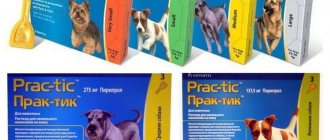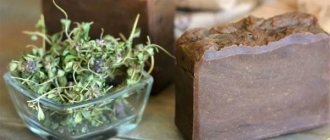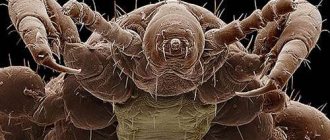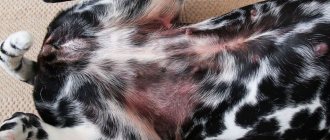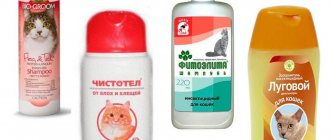Flea classification
Today there are more than two thousand species of fleas. It is almost impossible to distinguish them from each other without special equipment and without sufficient knowledge. However, without going into scientific terminology, they can be classified as follows:
- canine;
- felines;
- human;
- rat;
- chicken
What do fleas look like on dogs? (photo)
The flea's body has a laterally compressed shape and is covered with scales, bristles and spines. In length it reaches from one to five millimeters, although there are especially twice as many. The mouthparts are piercing-sucking type. Fleas do not have wings, which gives them additional maneuverability in the thick fur of animals. The long, strong limbs on the abdomen allow them to move quickly. The photo shows what fleas look like on a dog under a microscope and in real size.
How to remove fleas from a dog
If you do find fleas, then read the points on how to remove fleas from a dog:
- Act immediately, the sooner you start, the less time you will spend fighting parasites. Since fleas can reproduce quickly, a couple of weeks is enough for the larvae to grow into mature individuals ready for reproduction.
- Decide on a remedy. Carefully study the products presented in stores. Look at reviews on forums, talk with dog owners on the site, perhaps they will give you useful recommendations, or recommend proven medications.
- Please read the instructions carefully. Repeated treatment will be required, since not all products are capable of destroying flea eggs.
- It would not be superfluous to take care of prevention. Do not allow pets to interact with outdoor dogs and cats.
When choosing a product, you should pay attention to one specific one, and not use several drugs at the same time.
Not a single product guarantees that dogs will no longer get fleas. Therefore, be prepared to take preventative measures. Let's look at the main groups of funds:
- Flea drops. They are applied to the dog's withers to prevent swallowing.
- Special anti-flea collars. Very easy to use and lasts the entire time you wear it. They have a pronounced odor, the reaction to which can be poisoning. Collars have a deterrent effect.
- Special shampoos for fleas. The effect of the shampoo lasts for a week. Before use, it is necessary to check the dog’s reaction to this product. If a dog licks itself frequently, this method of control is dangerous for the animal itself.
- Flea sprays. They work on the principle of repelling. Carefully read the instructions for use and follow safety precautions. Do not allow your dog to lick the product from its fur!
- Pills. They are not such a popular remedy due to the risk of allergies in dogs.
You decide for yourself which product is best for your dog. Based on the age, breed and behavior of the animal.
Peculiarities of breeding dog fleas
The parasite multiplies at an incredible speed, but prefers to do this not on the animal’s body, but in secluded places in the external environment. On carpets, in cracks behind baseboards or in fallen leaves. Once every few days, the female lays a large number of eggs from which larvae emerge, which outwardly resemble small caterpillars covered with a dense protective shell. They feed on organic waste and, after several molting cycles, transform into a sexually mature individual awaiting a new victim.
Flea reproduction
Having drunk blood, the female lays a huge number of eggs at one time, but she does this not only on the animal’s body, therefore, when fighting pests, it is necessary to carefully clean the place where the animal is kept and where it stays.
Dog fleas reproduce using larvae in a variety of places. It is difficult to see the laid eggs, as they are about one millimeter in size. If a large number of eggs have accumulated in one place, then it will not be difficult to see them.
The hatched larvae look like maggots. They feed on excrement, humus and other organic waste, then wrap themselves in a cocoon, and from it they turn into a flea. They wait for a month to find a new animal.
How to effectively fight fleas in dogs, watch the video:
During her life, the female lays about 500 eggs, and they live for about three weeks.
Where do dogs get fleas?
Where can a dog pick up fleas and where do they come from? Anywhere, in fact. Fleas can live both outdoors and indoors, in basements. In the grass, in fallen leaves and even on bare ground. The risk of infection is always present, whether the dog is walked in the yard of a house, in specialized areas or in a dense forest. Even a dog that is not outdoors can be infected with parasites from other pets or neighbors. Fleas easily migrate from the entrance to the apartment through the open front door.
Parasites are incredibly jumpy, so even if you don’t let your pet get too close to other four-legged animals, you can’t be completely sure of its safety.
Many owners are very surprised how their exclusively domestic pet was able to “catch” parasites? It's very simple; insects and their larvae can be carried on clothes or the soles of shoes. They can enter the house even through open windows on the first floors.
Why did fleas appear on my domestic dog?
Bloodthirsty parasites can appear even in a domestic, clean, well-groomed dog. A pet can become infected through direct contact with a sick animal .
IMPORTANT ! Fleas have the ability to jump at a distance of more than 30 centimeters, both in length and height, so they can move onto the skin of a pet even when the animals sniff each other. An infected animal, shaking itself off, can shed flea eggs or larvae from its fur anywhere.
Insect larvae can be anywhere: in foliage, on grass, and even on bare ground , and a dog can pick them up simply by walking on a leash in the yard or in the park.
Larvae and flea eggs can stick to the soles of shoes and thus enter the house and then directly onto the animal. A previously ill animal may become re-infected after a course of treatment .
Signs of fleas on a dog:
- visible bites on the skin;
- The dog started to itch frequently;
- premature shedding;
- hair loss in certain areas of the skin;
- accumulation of white larvae on the fur;
- uncharacteristic behavior for a dog (irritability, loss of appetite, allergies).
ATTENTION ! Delayed treatment or inaction in this situation can lead to more serious illnesses and infections. Typhoid fever, tick-borne encephalitis, tuberculosis, salmonellosis - this is an incomplete list of diseases caused by fleas and can easily be transmitted to humans. The bites of such insects are quite painful. Fleas can carry on their bodies the larvae of various types of helminths susceptible to the human body.
Signs of fleas in a dog
The main signs of a dog being infected with fleas are:
- restless behavior and aggressiveness;
- constant scratching;
- increased shedding and the appearance of bald spots;
- wounds, sores and redness on the skin.
If symptoms are detected, it is necessary to examine the dog's coat. Pay special attention to the places on the withers, belly and behind the ears. Small brown insects, white eggs or tiny dark balls of excrement are fairly easy to spot.
Why are dog fleas dangerous?
Why are fleas dangerous for dogs? They cause discomfort to the pet and can serve as carriers of dangerous infections and diseases, such as plague, typhoid, encephalitis, as well as worm and salmonella eggs.
Many dog breeders believe that fleas are not dangerous to people and live exclusively on animals, while others fear that fleas from a dog can pass to humans. This is not entirely true. The parasite is not able to live permanently on humans, but it can bite. The consequences of a dog flea bite on a person can be serious if the flea is infected. In addition, a severe allergic reaction may occur.
Effective flea treatments for dogs
Any pet store now has a sufficient range of anti-flea drugs. The most common means are listed below. Their cost ranges on average from 100 to 700 rubles.
Shampoos
Shampoos have a rather preventive effect; their effect is short-lived. Based on their composition, they are divided into two types: based on natural ingredients and based on insecticides. The use of the latter should be approached with caution, as they can cause an allergic reaction.
When using, it is important that the composition does not come into contact with the mucous membranes and eyes of the animal during bathing. Carefully read the instructions for using the shampoo, it describes whether you can bathe puppies with it. Shampoos are usually harmless if they do not enter the body.
Average cost of flea shampoo: 150 rubles.
Sprays
Anti-flea sprays are quite effective, but problematic to use. When using, you need to protect yourself with a respirator and rubber gloves and do not direct the spray at the animal’s face. In addition, it is important to prevent licking the fur for several hours, otherwise a number of side effects may occur, such as vomiting and difficulty breathing. If this happens, you should contact a veterinary clinic, indicating which product was used.
You should try to spray the spray not on the dog’s fur, but on the skin of the dog, while protecting it from licking the drug with a special neck collar. For two days after using the product, the animal should not have contact with children and other animals; it should not be wetted or subjected to water procedures.
Average cost of flea spray: 300 rubles.
Anti-flea collars
The effect of a dog flea collar lasts for several months; it is recommended to wear it at the very beginning of the warm season and renew it after the expiration date. However, it is unlikely that it will be possible to cure a serious infection with just one collar.
Wearing it to nursing bitches and puppies is not recommended. It should be remembered that long-term use can cause dermatitis in the animal, so during the entire period of use it is worth monitoring the condition and well-being of the dog.
Average cost of an anti-flea collar: 600 rubles.
Special drops
Currently, they are the most effective and easy-to-use treatment. The number of drops is calculated based on the dog's weight. The active substance is distributed over the skin and quickly kills parasites, preventing their reappearance. The effect of the drug usually lasts about a month, after which it requires repeated application.
During the entire period, the dog should be protected from water procedures. The instructions for use describe how to properly administer flea drops to dogs.
Average cost of flea drops: 350 rubles.
Powders
The cheapest option would be to use powder. It is prepared to order in a veterinary pharmacy based on Butox. Before using it, you should conduct a series of tests on the dog’s skin and monitor its condition. But this method of treatment requires a fairly long course, on average about two weeks.
Average cost of flea powder: 150 rubles.
All of the above products (except shampoo) are very toxic, so you should carefully read the instructions.
Fleas on dogs
When selecting an antiparasitic agent, the following factors are taken into account:
- Pet's age. More gentle means are used to treat puppies and older animals.
- Breed. Each breed has its own characteristics, so for some dogs certain components of flea products can be deadly.
- Pet lifestyle. The concentration of the active ingredient in a flea product will be completely different for decorative dogs that spend most of their time at home, and for hunting dogs that are constantly in contact with wildlife.
- Health status. The presence of hypersensitivity to flea saliva in a pet requires special care in choosing products and combining them during the treatment process.
- Convenience and safety of using the drug. Of course, ease of use and safety of the product are key factors in choosing the appropriate method of controlling parasites.
Fleas are removed from dogs using shampoos, sprays, drops, powders and special collars, and each product has its own pros and cons.
Shampoos
Pros.
This is the safest means of combating fleas. The herbal ingredients included in the shampoos have an antipruritic, anti-inflammatory and wound-healing effect. Gentle shampoos, with a small amount of toxic substances, are often the only possible way to treat small puppies.
Minuses.
The shampoo is effective against small numbers of fleas. In case of extensive parasite infestation, shampoos do not cope, so combination therapy is required. Many shampoos contain permethrin, an anti-flea component that causes excessive salivation and vomiting if the product gets into the mouth. The shampoo is effective only at the time of use and does not protect the animal after bathing.
Sprays
Pros.
When applied correctly, it is highly effective. Often prescribed to treat puppies and small breed dogs. Duration of action is 1-2 months.
Minuses.
Inconvenient to apply. The spray must be sprayed over the entire surface of the body, so there is a risk of overdose of the drug. The dog must be treated with gloves and a respirator; the pet also needs to protect its nose, eyes and mouth. There is a danger of intoxication of the animal when licking the fur, so it is better to wear a special collar on the pet.
Anti-flea collars
Pros.
Easy to use and repels parasites. Collars with natural impregnation with essential oils are the most harmless. They are used for prevention, not treatment. They are convenient to use together with flea drops and sprays.
Minuses.
Chemically impregnated collars have a stronger effect, but have a number of contraindications. They should not be used on puppies up to six months old, as well as on older dogs and pregnant or lactating females. These collars are also not suitable for dogs with allergies and digestive disorders. The collar must be in constant contact with the skin, so it cannot just dangle around the neck, it needs to fit tightly to it. Two fingers should be placed between the collar and the skin, then the pet will be comfortable wearing it. Obviously, collars are not suitable for dogs with fluffy long hair.
Folk remedies
There are also folk remedies for fighting parasites based on decoctions and infusions of herbs and essential oils.
- A decoction of wormwood and dried twigs placed in the dog’s habitat will help effectively repel fleas.
- A paste of onion and garlic is applied to the animal’s withers.
- The solution can be prepared from lemongrass, eucalyptus and tansy oil.
- A decoction of celandine is suitable for rinsing wool while bathing.
- Essential oils of mint, eucalyptus and lavender are added to shampoos.
- It will also be useful to apply a few drops to the animal’s sleeping place.
- You can place citrus peels in your dog's kennel.
- A solution of soda and salt in a one-to-one ratio is suitable for disinfecting the room in which an infected pet lives.
- To treat wool, in the absence of specialized shampoos, it is recommended to use tar soap.
Most herbs for making infusions, as well as essential oils, can be found at the pharmacy. And although these products are not so effective, the natural composition will be as harmless as possible for animals and their owners.
How to get rid of fleas on a puppy?
Fleas can pose a particular danger to puppies, because their immune system has not yet developed and the consequences can be much more serious. In the future, this can have an extremely negative impact on the health and development of the individual.
But treatment should also be approached with particular care, because even many traditional methods of struggle are not always suitable for a fragile body. It is highly recommended to consult a veterinarian or a consultant at a pet store in this matter.
The shampoo you purchase must be suitable for puppies, which must be indicated on the packaging. The situation is similar when choosing a collar.
When it comes to herbal home remedies, you should avoid those that smell strongly, as they can damage your puppy's developing sense of smell.
How to remove fleas from dogs?
Treatment . Freeing your dog from fleas must begin with preparatory measures.
First, you need to replace the dog’s existing bedding, or boil it and other care items. Treat your apartment or dog house and area with insecticides because... the fleas probably managed to lay their eggs in secluded places.
If your dog has allergic symptoms, then you need to contact a veterinary clinic and find out if the dog has any contraindications to the use of certain insecticides and medications against fleas.
When choosing medications, the veterinarian takes into account the age of the dog, its state of health, the degree of parasite infection, the presence of pregnancy, lactation and the dog’s lifestyle, breed, whether the dog is being treated with any medications.
In the future, you will need to thoroughly comb the dog and bathe it in the bathroom using a special shampoo. After that, all combed out fleas and their eggs must be washed down the drain. After 2-4 days, you will need to re-treat your dog with the drug. After a month, this treatment must be repeated to prevent re-infection.
A large number of anti-flea products are currently used to combat fleas.

